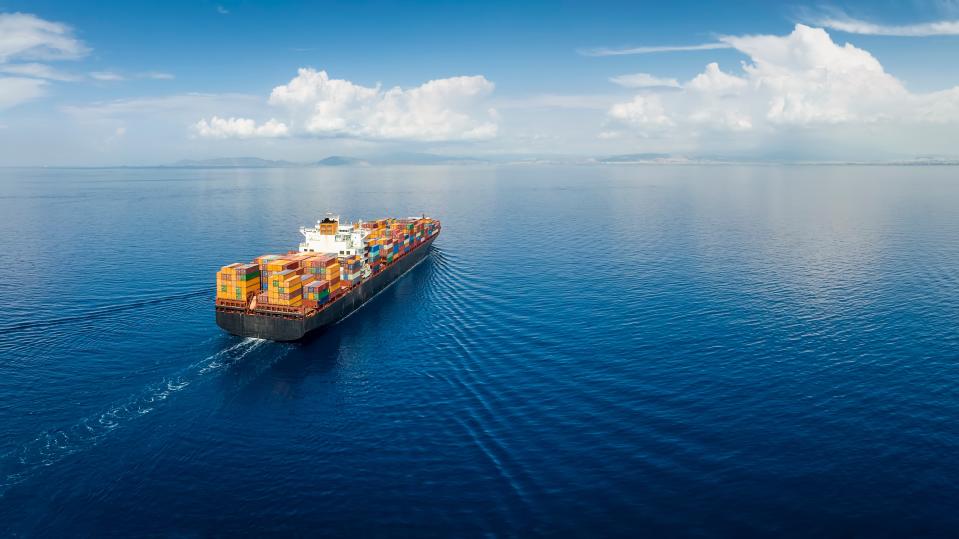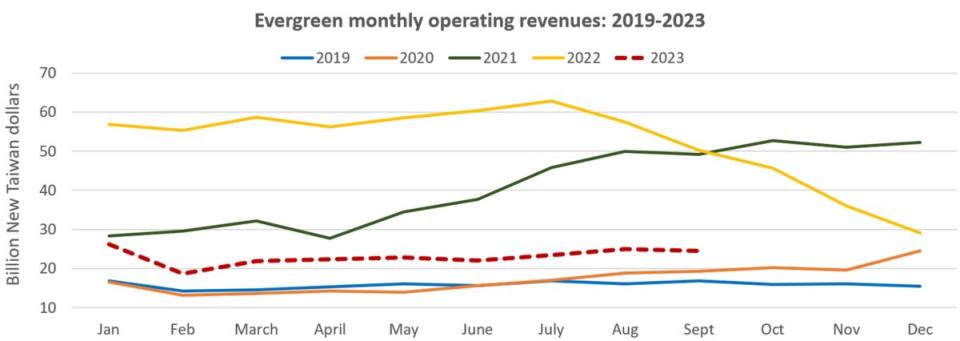Shipping line earnings preview: A mix of black, red and very red ink

The shipping rate rebound that began this summer is over. Financial analysts covering shipping line stocks are slashing their forecasts.
Even so, many liner companies are expected to post at least some profits for the third quarter of this year — and all of them are still sitting on historically large cash hoards. Today’s liner companies are like Powerball winners who’ve just taken big pay cuts at their day jobs.
“Container shipping companies are awash with cash and therefore we think they are under no pressure to cut capacity,” said Deutsche Bank analyst Andy Chu in a research note earlier this month.
“As we see no signs of this changing near term, we think this will likely result in freight rates continuing to be under pressure,” said Chu, who downgraded stocks of Maersk and Hapag Lloyd from “hold” to “sell.” Denmark’s Maersk and Germany’s Hapag-Lloyd are the world’s second- and fifth-largest carriers, respectively.
According to Jefferies analyst Omar Nokta, “Spot freight rates surged across the mainlines in July and August but quickly fell back to loss-making levels in September and have held mostly flat for the past several weeks. Overall earnings are likely to come down,” he said in a third-quarter earnings outlook released Monday.

Nokta has repeatedly cut his earnings forecast for Israel-based Zim (NYSE: ZIM) as this year has progressed. He still expects Maersk and Hapag-Lloyd to post profits in the third quarter, but he foresees a sea of red for Zim, the world’s 10th-largest ocean carrier.
Nokta now forecasts that Zim will lose $1.83 per share in Q3 2023, equating to an adjusted net loss of $220 million. He expects the company to lose $647 million in full-year 2023, versus the Bloomberg consensus estimate for a full-year loss of $641 million.
Still some positives amid market gloom
Indicators from other ocean carriers are not quite as grim.
China’s Cosco Group, the world’s fourth largest liner operator, announced preliminary results showing net income of 6.33 billion yuan ($866 million) for Q3 2023. That’s down 44% from second-quarter profits of $1.54 billion, but it’s still six times more than Cosco’s net income in Q3 2019, pre-COVID.
Cosco subsidiary OOCL published its Q3 2023 revenue-per-container statistics this month. While its numbers continue to decline, the pace of that decline has eased.

Hong Kong-based OOCL had $2,635 in revenue per forty-foot equivalent unit in the trans-Pacific trade during Q3 2023, relatively flat (down 2%) versus the second quarter.
Globally, OOCL’s revenue per TEU came in at $1,887 per FEU, down 11% from Q2 2023, driven by a 26% plunge in the trans-Atlantic lane. OOCL’s global average revenue per FEU was essentially unchanged (up 2%) versus Q3 2019, pre-COVID.
Taiwan’s Evergreen, the world’s seventh-largest carrier, discloses monthly operating revenues prior to releasing its quarterly financials. It had operating revenues of 72.8 billion New Taiwan dollars ($2.25 billion) in Q3 2023, up 8% from the second quarter of this year.
Evergreen’s Q3 2023 revenues are up 46% versus revenues in the same period in 2019. However, most of that gain is due to a larger fleet. Evergreen’s fleet capacity has increased 31% since Jan. 1, 2020, according to data from Alphaliner.

Hawaii-based niche carrier Matson (NYSE: MATX) is expected to pre-release Q3 results in the coming days. Matson has consistently reported above-market rates for its premium trans-Pacific service and has successfully wooed some shippers away from air cargo. If its stock price is any indication, investors expect Matson to continue to outperform.
Matson’s shares were only a few dollars shy of their 52-week high on Tuesday. According to data from Koyfin, which adjusts share pricing to account for dividends, Matson’s stock is up 45% year to date (YTD).
That is better than most shipping stocks, including those in tanker and gas shipping segments where rates are highly profitable, and is triple the rise of the S&P 500 index. Matson’s share action is the mirror opposite of Zim’s, which is down 44% YTD.

Click for more articles by Greg Miller
Related articles:
Container shipping has a Europe problem and it’s getting worse
Trouble ahead: Container shipping rates sinking further into the red
US container imports rise in line with pre-COVID peak season pattern
Rebound in trans-Pacific container shipping rates has stalled
Asia-US spot rates top contract rates for first time since 2022
Maersk hikes 2023 guidance but warns of ‘years’ of challenges
‘Colossal’ tidal wave of new container ships about to strike
The post Shipping line earnings preview: A mix of black, red and very red ink appeared first on FreightWaves.
